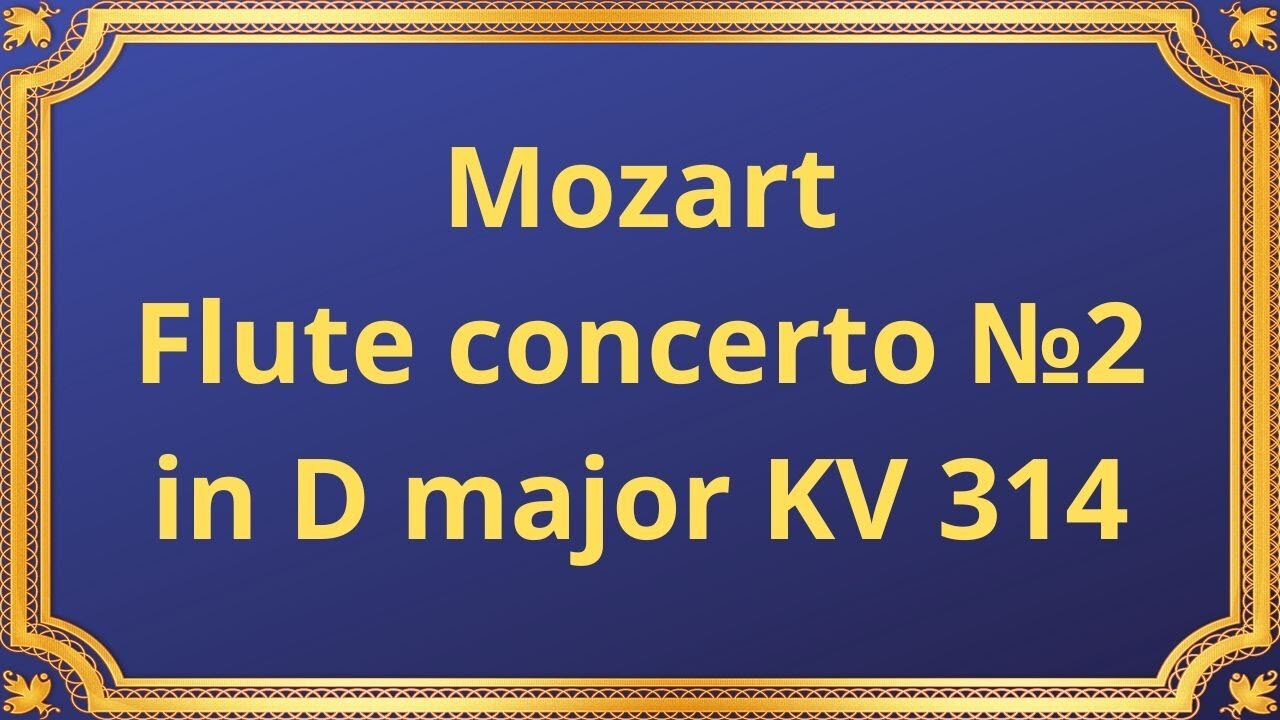Premium Only Content

Wolfgang Amadeus Mozart Flute concerto №2 in D major KV 314
#ClassicalMusic #Mozart #FluteConcerto #DMajor #KV314 #MusicalComposition #OrchestralMusic #WolfgangAmadeusMozart #Masterpiece #Mozart #Chamber_music #Classical_music #Flute_concerto #Musical_composition
Publication date 1930
Wolfgang Amadeus Mozart: Flute concerto no.2 in D KV 314 (1778):
1 allegro aperto
2 adagio non troppo
3 rondo: allegretto
Marcel Moyse. Piero Coppola
Wolfgang Amadeus Mozart's Flute Concerto No. 2 in D Major, KV 314, stands as a remarkable testament to the genius of this renowned composer. Created during the late 18th century, this musical composition showcases Mozart's deep understanding of the flute's expressive capabilities. With its melodic charm and technical brilliance, the concerto continues to captivate audiences worldwide.
Mozart composed the Flute Concerto No. 2 in D Major in 1778, during a period of prolific creativity. The concerto was commissioned by the accomplished Dutch flutist, Ferdinand De Jean. Mozart's deep admiration for the flute is evident in this composition, as he sought to highlight the instrument's unique qualities through his melodic and virtuosic writing. The work was premiered in Mannheim, Germany, with De Jean as the soloist, and it quickly gained popularity for its exquisite craftsmanship.
The concerto follows the traditional three-movement structure: Allegro aperto, Adagio ma non troppo, and Rondo: Allegro. The opening movement, Allegro aperto, introduces the flute's lyrical melodies, accompanied by the vibrant orchestral sections. The second movement, Adagio ma non troppo, displays Mozart's gift for creating heartfelt and tender melodies, allowing the flute to soar with expressiveness and emotional depth. The final movement, Rondo: Allegro, showcases Mozart's playful and energetic style, with the flute engaging in lively dialogues with the orchestra, culminating in a dazzling finale.
Mozart's Flute Concerto No. 2 in D Major pushes the boundaries of flute technique of its time. The solo part demands exceptional skill, agility, and breath control from the flutist. Mozart explores a wide range of tonal colors and articulations, allowing the flute to shine in both virtuosic passages and moments of delicate intimacy. The concerto also demonstrates Mozart's innovative use of orchestration, with carefully crafted interactions between the solo flute and various sections of the orchestra.
Mozart's Flute Concerto No. 2 in D Major continues to be celebrated as one of the most beloved works in the flute repertoire. Its timeless melodies and technical brilliance have made it a favorite among flutists and classical music enthusiasts alike. The concerto's influence extends beyond its initial creation, inspiring generations of composers and performers to explore the expressive potential of the flute in their own works. Its enduring popularity ensures that this masterpiece will continue to enchant audiences for centuries to come.
Wolfgang Amadeus Mozart's Flute Concerto No. 2 in D Major, KV 314, represents a pinnacle of musical achievement. Through its melodic beauty, technical brilliance, and innovative orchestration, this concerto showcases Mozart's exceptional talent and deep understanding of the flute as an instrument. Its historical significance, structural ingenuity, and enduring impact have solidified its place as an integral part of classical music history. As we continue to appreciate and explore Mozart's musical genius, the enchanting journey of this flute concerto serves as a testament to the timeless power and beauty of his compositions.
You have the opportunity to support the channel
https://www.donationalerts.com/r/radsiaral
-
 20:26
20:26
Classical music_Music Inspiration
1 month agoJohann Sebastian Bach Orchestral Suite No. 2 in B minor, BWV 1066
862 -
 1:38:08
1:38:08
HELMETFIRE
4 hours ago🟢GAMING WITH FIRE EP4🟢RUMBLE TAKEOVER!🟢
24.7K -
 5:16:57
5:16:57
iCheapshot
5 hours agoCheap Plays Warzone Again? What!?
23.4K1 -
 2:30:14
2:30:14
PandaSub2000
7 hours agoCHAOS & FURY | Episode 27: Attack Of The Cranks (Edited Replay)
27.8K1 -
 3:09:39
3:09:39
Spartan
4 hours agoSpartan - Pro Halo Player for OMiT | Ranked for a little bit
17.3K1 -
 15:15
15:15
Adam Does Movies
1 day ago $3.00 earnedHappy Gilmore 2 - Movie Review
29K17 -
 3:10:16
3:10:16
Toolman Tim
7 hours agoDOOM: The Dark Ages ALMOST DONE! | The Gaming Thinktank
12.6K -
 LIVE
LIVE
SkrimpNGritZ
5 hours agoSkrimpNGritz Off the Grid Live
44 watching -
 16:29
16:29
Mrgunsngear
1 day ago $0.72 earnedGirsan Witness 2311 Match X - Staccato XC On A Budget But Does It Work?
19.2K6 -
 14:54
14:54
Tundra Tactical
6 hours agoTundy's SIG MEME Review 2: The Reload!!!
15.7K4